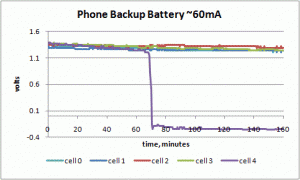I cut an oddly shaped piece of the ubiquitous clear plastic
that lots of things come packaged in these days, folded it, and have a nice little cover to insulate the ends of the battery pack (as well as letting the cells’ mismatched beauty show thru). One piece of scotch tape around it will hold the cover together and keep it from sliding off.
This is as much a plug for creative use of that nice plastic material as a woot for being done.
As long as I had the battery unplugged and it had been “charging” from
the phone for a day or so, I ran a quick discharge test on it. As one would expect with mismatched cells, one gave out (long) before the others, essentially defining the capacity of the battery. That cell went into reverse charge for quite a while (ouch!) before the whole battery dropped below the 0.95V/cell the Arduino software defaults to. I should change the code to kill the test if any single cell drops below 0.95V (configurable) rather than when the whole battery drops to 0.95VxNumCells.
I used a nominal 100 Ω load resistor, and measured the current at 65mA at the beginning. (The battery started at 6.73V under load, so the resistor was a little over 100Ω.) Using a guess of 60mA as the average current before the first cell died at 70 mins, that gives the bad cell a capacity of about 70mA-hr. That’s still more than 3 hours, so I think it’s OK.
This project is now officially DONE!
Update 8/7/16: We had a power outage of around 4 hours today, and the phone survived with time/date intact thanks to the battery pack. For a ragtag bunch of misfits 7 years old, that’s wonderful service!


